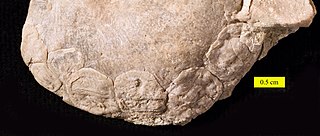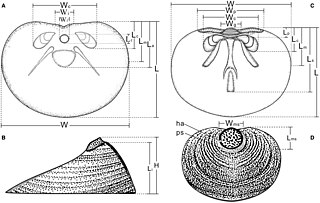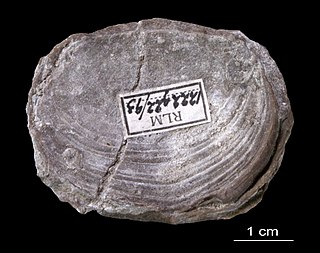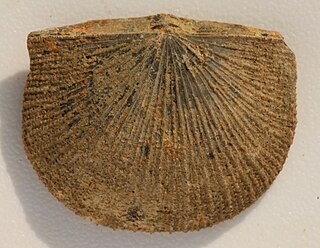The Treatise on Invertebrate Paleontology published by the Geological Society of America and the University of Kansas Press, is a definitive multi-authored work of some 50 volumes, written by more than 300 paleontologists, and covering every phylum, class, order, family, and genus of fossil and extant invertebrate animals. The prehistoric invertebrates are described as to their taxonomy, morphology, paleoecology, stratigraphic and paleogeographic range. However, taxa with no fossil record whatsoever have just a very brief listing.

Craniata is a class of brachiopods originating in the Cambrian period and still extant today. It is the only class within the subphylum Craniiformea, one of three major subphyla of brachiopods alongside linguliforms and rhynchonelliforms. Craniata is divided into three orders: the extinct Craniopsida and Trimerellida, and the living Craniida, which provides most information on their biology. Living members of the class have shells which are composed of calcite, though some extinct forms my have aragonite shells. The shells are inarticulate and are usually rounded in outline. There is no pedicle; the rear edge of the body cavity is a smooth and flat wall perforated by the anus. This class of brachiopods has an unsupported lophophore with only a single row of tentacles. In the absence of a pedicle, the shell is usually attached directly to a hard substrate. Many craniiforms are encrusting animals which attach directly to the shell of another animal, usually another brachiopod. The plicae from the host brachiopod will then appear within the shell of the craniiform.
The Obolellata are a class of Rhynchonelliform brachiopods with two orders, Obolellida and Naukatida. They are essentially restricted to the lower-middle Cambrian.

Orthida is an extinct order of brachiopods which appeared during the Early Cambrian period and became very diverse by the Ordovician, living in shallow-shelf seas. Orthids are the oldest member of the subphylum Rhynchonelliformea, and is the order from which all other brachiopods of this group stem. Physically they are usually strophic, with well-developed interareas. They also commonly have radiating ribs, sulcus, and fold structures. Typically one valve, often the brachial valve, is flatter than the other. The interior structure of the brachial valves are usually simple. In shape they are sub-circular to elliptical, with typically biconvex valves.

The Craniidae are a family of brachiopods, the only surviving members of the subphylum Craniiformea. They are the only members of the order Craniida, the monotypic suborder Craniidina, and the superfamily Cranioidea; consequently, the latter two taxa are at present redundant and rarely used.There are three living genera within Craniidae: Neoancistrocrania, Novocrania, and Valdiviathyris. As adults, craniids either live freely on the ocean floor or, more commonly, cement themselves onto a hard object with all or part of the ventral valve.

Atrypa is a genus of brachiopod with shells round to short egg-shaped, covered with many fine radial ridges, that split further out and growth lines perpendicular to the costae and 2-3 times wider spaced. The pedunculate valve is a little convex, but tends to level out or even become slightly concave toward the anterior margin. The brachial valve is highly convex. There is no interarea in either valve. Atrypa was a cosmopolitan and occurred from the late Lower Silurian (Telychian) to the early Upper Devonian (Frasnian). Other sources expand the range from the Late Ordovician to Carboniferous, approximately from 449 to 336 Ma. A proposed new species, A. harrisi, was found in the trilobite-rich Floresta Formation in Boyacá, Colombia.

Strophomenida is an extinct order of articulate brachiopods which lived from the lower Ordovician period to the mid Carboniferous period. Strophomenida is part of the extinct class Strophomenata, and was the largest known order of brachiopods, encompassing over 400 genera. Some of the largest and heaviest known brachiopod species belong to this class. Strophomenids were among the most diverse and abundant brachiopods during the Ordovician, but their diversity was strongly impacted at the Late Ordovician mass extinction. Survivors rediversified into new morphologies in the Silurian, only to be impacted once again at the Late Devonian mass extinction. However, they still survived till the mid Carboniferous.

Brachiopods, phylum Brachiopoda, are a phylum of trochozoan animals that have hard "valves" (shells) on the upper and lower surfaces, unlike the left and right arrangement in bivalve molluscs. Brachiopod valves are hinged at the rear end, while the front can be opened for feeding or closed for protection. Two major categories are traditionally recognized, articulate and inarticulate brachiopods. The word "articulate" is used to describe the tooth-and-groove structures of the valve-hinge which is present in the articulate group, and absent from the inarticulate group. This is the leading diagnostic skeletal feature, by which the two main groups can be readily distinguished as fossils. Articulate brachiopods have toothed hinges and simple, vertically-oriented opening and closing muscles. Conversely, inarticulate brachiopods have weak, untoothed hinges and a more complex system of vertical and oblique (diagonal) muscles used to keep the two valves aligned. In many brachiopods, a stalk-like pedicle projects from an opening near the hinge of one of the valves, known as the pedicle or ventral valve. The pedicle, when present, keeps the animal anchored to the seabed but clear of sediment which would obstruct the opening.

Acrotretida is an extinct order of linguliform brachiopods in the class Lingulata. They lived from the Lower Cambrian to the Middle Devonian, with their peak diversity from the Middle Cambrian to the Ordovician. Acrotretida contains the sole superfamily Acrotretoidea.

Rhynchonelliformea is a major subphylum and clade of brachiopods. It is roughly equivalent to the former class Articulata, which was used previously in brachiopod taxonomy up until the 1990s. These so-called articulated brachiopods have many anatomical differences relative to "inarticulate" brachiopods of the subphyla Linguliformea and Craniformea. Articulates have hard calcium carbonate shells with tongue-and-groove hinge articulations and separate sets of simple opening and closing muscles.
Mickwitziids are a Cambrian group of shelly fossils with originally phosphatic valves, belonging to the Brachiopod stem group, and exemplified by the genus Mickwitzia – the other genera are Heliomedusa and Setatella. The family Mickwitziidae is conceivably paraphyletic with respect to certain crown-group brachiopods.

Paterinata is an extinct class of linguliform brachiopods which lived from the lower Cambrian ("Tommotian") to the Upper Ordovician ("Ashgill"). It contains the single order Paterinida and the subfamily Paterinoidea. Despite being some of the earliest brachiopods to appear in the fossil record, paterinides stayed as a relatively subdued and low-diversity group even as other brachiopods diversified later in the Cambrian and Ordovician. Paterinides are notable for their high degree of convergent evolution with rhynchonelliform (articulate) brachiopods, which have a similar set of muscles and hinge-adjacent structures.

Trimerellida is an extinct order of craniate brachiopods, containing the sole superfamily Trimerelloidea and the families Adensuidae, Trimerellidae, and Ussuniidae. Trimerellidae was a widespread family of warm-water brachiopods ranging from the Middle Ordovician to late Silurian (Ludlow). Adensuidae and Ussuniidae are monogeneric families restricted to the Ordovician of Kazakhstan.

Siphonotretida is an extinct order of linguliform brachiopods in the class Lingulata. The order is equivalent to the sole superfamily Siphonotretoidea, itself containing the sole family Siphonotretidae. They were most abundant in the Late Cambrian and Early Ordovician, and were traditionally considered to have gone extinct in the Upper Ordovician (Ashgill). However, they may have been present as early as Cambrian Stage 4, and as late as the Silurian (Ludlow). Siphonotretoids were originally placed as a superfamily of Acrotretida, before being raised to their own order.

Kutorginates (Kutorginata) are an extinct class of early rhynchonelliform brachiopods. The class contains only a single order, Kutorginida. Kutorginates were among the earliest rhynchonelliforms, restricted to the lower-middle part of the Cambrian Period. Despite this short span of time, they were among the most abundant brachiopods prior to their extinction.

The orthotetides (Orthotetida) are an extinct order of brachiopods in the class Strophomenata. Though not particularly diverse or abundant relative to strophomenides (Strophomenida) or productides (Productida), orthotetides were nevertheless the longest-lasting order of strophomenates, surviving from the Middle Ordovician (“Llanvirn”) up until the Late Permian. Externally, many orthotetides are difficult to distinguish from strophomenides. Most fundamental differences between the two orders are internal: orthotetides have more elaborate cardinal processes and a greater diversity of shell microstructure.
A rhynchonelliform class, characterised by the presence of a colleplax; closest relative (?): Salanygolina.
Ussuniidae is a monogeneric family of Ordovician brachiopods aligned with the Trimerellids, but showing additional similarities to the craniids and considered intermediate in morphology.
Mesolobus is an extinct genus of brachiopod belonging to the order Productida and family Rugosochonetidae.
Diaphragmus is an extinct genus of brachiopod belonging to the order Productida and family Linoproductidae. Specimens have been found in Carboniferous beds in North America.











